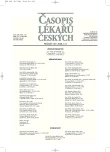Mitochondrial Neurogastrointestinal Encephalomyopathy (MNGIE)
Authors:
T. Honzík 1; M. Tesařová 1; H. Hansíková 1; J. Krijt 2; P. Beneš 3; J. Zámečník 4; L. Wenchich 1; J. Zeman 1,2
Authors‘ workplace:
Klinika dětského a dorostového lékařství 1. LF UK a VFN, Praha
1; Ústav dědičných poruch metabolismu 1. LF UK a VFN, Praha
2; Interní oddělení Nemocnice na Homolce, Praha
3; Ústav patologie a molekulární medicíny 2. LF UK a FN Motol, Praha
4
Published in:
Čas. Lék. čes. 2006; 145: 665-670
Category:
Case Report
Overview
Background.
Mitochondrial neurogastrointestinal encephalomyopathy (MNGIE) is a disorder with autosomal recessive inheritance caused by mutations in the gene encoding thymidine phosphorylase (TP). TP deficiency results in imbalance of mitochondrial pool of nucleotides leading secondary to multiple deletions and depletion of mitochondrial DNA (mtDNA) and impairment of oxidative phosphorylation system. The disease is clinically characterized by gastrointestinal dysmotility with symptoms of pseudo-obstruction, severe failure to thrive, ptosis, leukoencephalopathy, peripheral neuropathy and myopathy. We present results of the clinical, histochemical, biochemical and molecular analyses of the first Czech patient with MNGIE syndrome.
Methods and Results.
Man, 33-years old with twenty-year history of failure to thrive (height 168 cm, weight 34 kg) and progressive gastrointestinal dysmotility, external ophthalmoplegia, leucoencephalopathy and peripheral neuropathy was recommended to metabolic center. Histochemical analyses in muscle biopsy showed the presence of „ragged red fibers“ with focal decrease of cytochrome c oxidase activity, but spectrophotometric analyses in isolated muscle mitochondria revealed normal activities of all respiratory chain complexes. Metabolic investigation revealed markedly increased plasma level of thymidine (6.6 μmol/l, controls <0.05 μmol/l) and deoxyuridine (15 μmol/l, controls <0.05 μmol/l). The activity of TP in isolated lymphocytes was low (0.02 μmol/hour/mg protein, reference range 0.78±0.18). Molecular analyses in muscle biopsy revealed multiple mtDNA deletions and homozygous mutation 1419G>A (Gly145Arg) was found in gene for TP. Both parents are heterozygotes.
Conclusions.
MNGIE has to be considered in patients presenting with a combination of gastrointestinal and neurological symptoms. Plasma level of thymidine may serve as the best method for laboratory screening of MNGIE, but molecular analyses are necessary for genetic counselling and prenatal diagnosis in affected families.
Key words:
MNGIE, gastrointestinal dysmotility, thymidine, thymidine phosphorylase, ECGF1.
Labels
Addictology Allergology and clinical immunology Angiology Audiology Clinical biochemistry Dermatology & STDs Paediatric gastroenterology Paediatric surgery Paediatric cardiology Paediatric neurology Paediatric ENT Paediatric psychiatry Paediatric rheumatology Diabetology Pharmacy Vascular surgery Pain management Dental HygienistArticle was published in
Journal of Czech Physicians

Most read in this issue
- Spontaneous Pneumothorax
- Meconium Ileus as a First Symptom of Cystic Fibrosis in a Newborn
- Extent of Tuberculin Skin Testing Spot in Bacteriologically Verified Tuberculosis
- Mitochondrial Neurogastrointestinal Encephalomyopathy (MNGIE)
